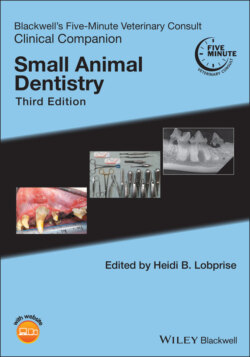Читать книгу Blackwell's Five-Minute Veterinary Consult Clinical Companion - Группа авторов - Страница 33
ОглавлениеChapter 4 Complete DentalCleaning
INDICATIONS
To remove deposits of plaque, calculus and debris from teeth.
Another term, prophylaxis, is often used, but is less accurate as it implies prevention, which is the case only in cleaning teeth in stage 1 periodontal disease.
EQUIPMENT (see Chapter 9)
Gloves, mask, eye protection
Dilute chlorhexidine rinse (0.12%)
Mouth wedge or gag
Dental mirror
Calculus forceps (Figure 4.1)
Scaler (ultrasonic, sonic) (Figure 4.2)
Hand scaler (Jacquette)
Disclosing solution (optional)
Slow speed polisher, prophy angle, prophy cup
Polishing paste
Fluoride (optional)
Figure 4.1 Calculus forceps.
Figure 4.2 Prophy paste, prophy angle, and ultrasonic scaling tip.
Figure 4.3 Applying dilute chlorhexidine prior to starting the dental procedure.
PROCEDURE
General anesthesia with cuffed endotracheal tube, monitoring, and supportive care.
Gently flush oral cavity with dilute chlorhexidine (Figure 4.3); avoid getting solution on nasal mucosa, especially in cats.
Initial assessment to identify areas of significant disease that might require therapy, in particular those areas that were not apparent on the alert examination.Palatal aspect of maxillary canine – deep pockets.Pockets at either aspect of mandibular first molar.Any worn, chipped, fractured, or discolored teeth.
Gently dislodge larger sections of calculus with calculus forceps; take care not to damage teeth (Figure 4.4).
Use mechanized scaler (ultrasonic or sonic) to continue to remove gross deposits of calculus from crown surfaces.Figure 4.4 Gently use the calculus forceps to dislodge large pieces of calculus.Figure 4.5 Use the side of the ultrasonic scaler head, not the tip.
Use side of scaler tip, not end (Figure 4.5).Use sufficient water spray for coolant; replace scaler stack if tip overheats.Apply side of scaler to individual tooth for no longer than 10–12 seconds at a time; return to the tooth later if additional scaling is necessary.Use the sharp tip of a hand scaler (Jacquette) to remove remaining deposits of calculus in grooves (upper fourth premolar development groove); do not use tip of ultrasonic scaler there (Figure 4.6).Use disclosing solution or air syringe to identify any remaining deposits of calculus.
Complete examination, probing (Figure 4.7), and intraoral radiology (see Chapters 1–3).
Additional therapyPeriodontal pockets (see Chapter 5).Extractions as needed (see Chapters 6 and 7).Figure 4.6 The sharp tip of a hand scaler can remove the remaining calculus in developmental grooves.Figure 4.7 Once the calculus is gone, use a probe to identify possible presence of pockets.
Polishing (Figure 4.8)Use proper speed (less than 3000 rpm), sufficient prophy paste, and moderate pressure to gently splay the foot of the prophy cup.Note: try the prophy cup on your fingernail; if it generates heat, adjust the speed, amount of paste, or pressure to a safer level.Polish each tooth surface, no more than 4–10 seconds per tooth. If further polishing is needed, continue to other teeth and return to this tooth for additional polishing later.
IrrigationWith air–water syringe or blunt‐tipped needle on syringe, rinse tooth surfaces and subgingival areas to remove any remnants of calculus or paste, which could cause a periodontal abscess if left (Figure 4.9).The air syringe can be used to gently dry the tooth surface (or in the pocket) to identify any calculus remnants (discolored or chalky) (Figure 4.10).Figure 4.8 Use copious prophy paste and moderate pressure to splay the prophy cup foot, but not to excess.Figure 4.9 Thoroughly rinse the tooth surfaces.Figure 4.10 Air dry the tooth surfaces to visualize remaining calculus.
FluorideFor additional antibacterial activity, and for remineralization and desensitization.When indicated (avoid in renal patients), apply acidulate phosphate fluoride to dry tooth surfaces and leave on according to manufacturer’s recommendation.Air blow or wipe off; rinsing deactivates most fluorides.Avoid allowing ingestion.
COMMENTS
This complete dental cleaning description deals with crown surfaces only. It is imperative to identify and treat any subgingival lesions thoroughly (see Chapter 5).
Appropriate preoperative diagnostics when indicated prior to procedure.
Appropriate antimicrobial and pain management therapy when indicated.
Appropriate patient monitoring and support during anesthetic procedures.
See also the following chapters:
Chapter 5
Chapter 6
Chapter 7
Chapter 9
Author: Heidi B. Lobprise, DVM, DAVDC
Consulting Editor: Heidi B. Lobprise, DVM, DAVDC, DVM, DAVDC
